Beetle Diet: What Do Beetles Eat?
Beetles are insects that have a head, thorax, and abdomen. They have tough and solid outer bodies and strong jaws that are well adapted to eat a variety of food. Many beetles have wings, or more specifically, modified wings. Beetles that eat plants and crops are called herbivores. Beetles that eat wood are called xylophages. Beetles that eat decaying matter are called scavengers. Some beetles eat the larvae of other beetles and insects. Some beetles eat aquatic creatures and amphibians.
Beetles are quintessential insects—they have a head, abdomen, thorax and multiple legs. Their outer bodies are tough and solid. Their jaws are strong and solid, with chewing mouthparts that are well adapted to eat a wide variety of food. Interestingly, many beetles have wings, or more specifically, modified wings. The first pair of wings serves primarily a protective purpose, as they are small, but quite hard. The second pair of wings allows some breed of beetle to fly. Many beetles catch our attraction with their brightly colored outer shells.
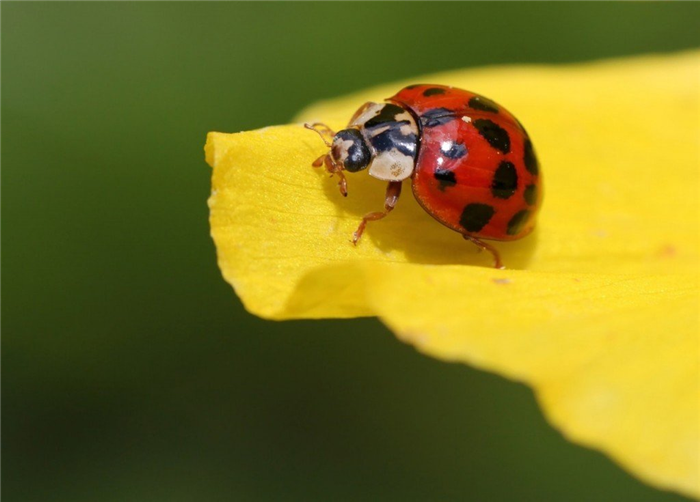
Beetles belong to an insect class called Coleoptera, which is a Greek word that means “sheath-wing”. Coleoptera happens to be the largest order of the class of insects. Many evolutionary scientists opine that a few thousand species of this order have yet to be identified. Presently, there are 400,000 known species of beetle already!
Because there are so many species of beetles, their diet can vary greatly. From decaying leftovers to aquatic creatures, they have manifested remarkable feeding abilities. Diving into that a bit deeper let’s take a look at typical food that different varieties of beetles eat.
Recommended Video for you:
Plants and Crops
Most beetles are herbivores, meaning they feed exclusively on plants. This includes roots, leaves, seeds, nectar, crops, and fruits. Beetle breeds like the cottonwood leaf beetle and elm leaf beetle consume leaves. This leaves holes in the leaves, which finally results in leaf discoloration and eventual death!
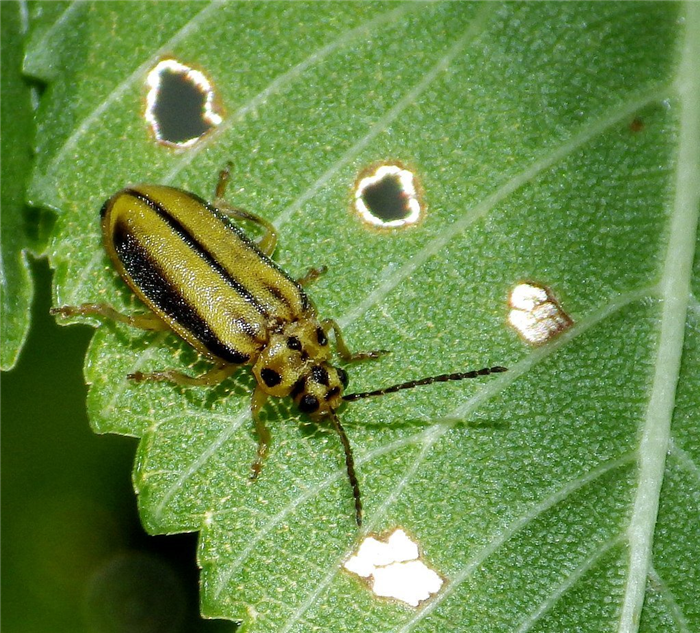
Elm leaf beetle feeding on a leaf and creating holes on it (Photo Credit : Sarah Zukoff / Flickr)
Beetle varieties like rice weevils and primitive weevils feed on crops like rice and grains. They are abhorred by farmers for their crop-eating addiction. Driedfruit beetles and figeater beetles devour fruits and figs, as their names imply. Their diet typically includes soft fruit, persimmons, fallen citrus and figs.
Wood and Furniture
Many beetle varieties are similar to termites, in that they feed on wood. Beetles like the longhorn beetle and powder post beetle can cause extensive damage to a living tree. They are nefarious for gorging on untreated lumber, wooden artefacts, and wooden furniture.
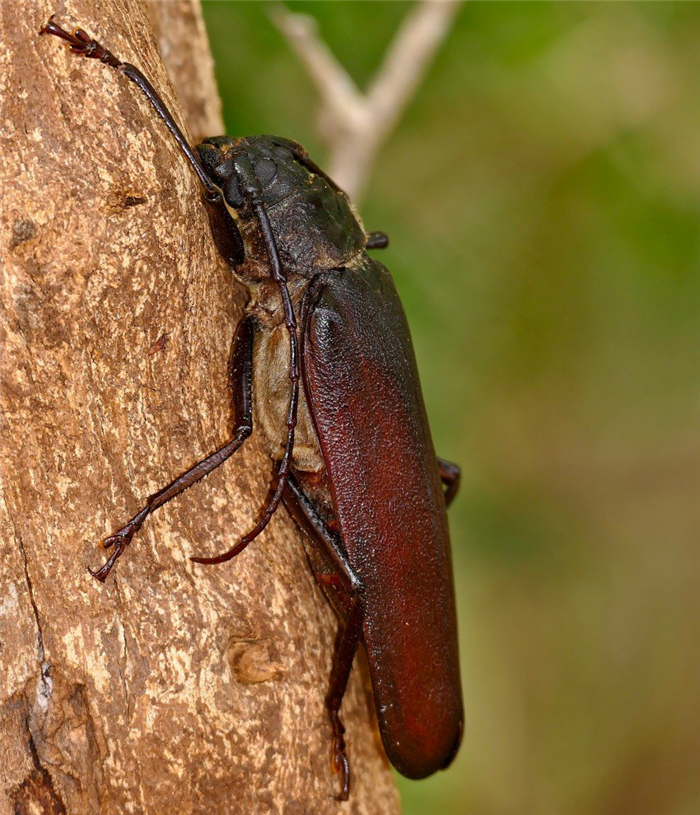
Longhorn beetle feeding on wood (Photo Credit : Pixabay)
Decaying Matter
Many beetle breeds are scavengers. They consume decaying organic matter to survive. Carrion beetles, clown beetles, and scarab beetles survive by feeding on decayed plant leaves, fallen wood pieces, animal dung, and even dead animal cadavers.
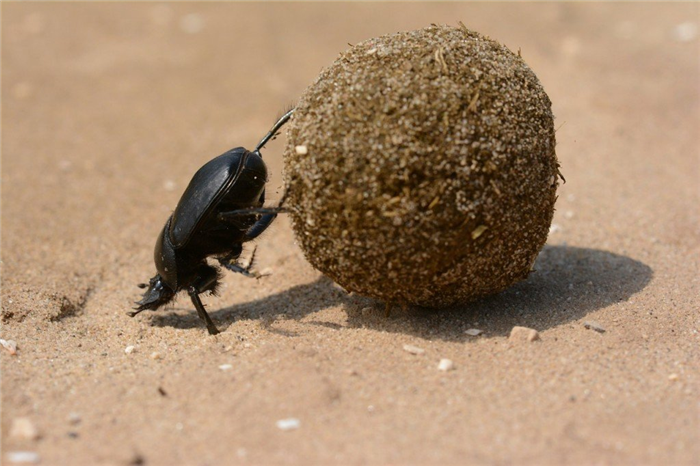
Scarab beetle feeding on animal dung (Photo Credit : Pixabay)
Mildew beetles feed on fungus in damp and moist areas. As fungi is their main source of food, mildew beetle are sometimes found in bathrooms, as these are areas with high humidity levels. High humidity permits the growth and development of both the beetle and their food.
Insects and Larvae
Besides being herbivores and scavengers, some beetles also demonstrate carnivorous habits! Oftentimes, they dine on the larvae of other beetles and insects. Some varieties of ground beetles are infamous for eating larvae. Lady beetles, on the other hand, like other insects. They typically feed on caterpillars, aphids, scale insects, mites, and almost every pest that farmers and gardeners fear.
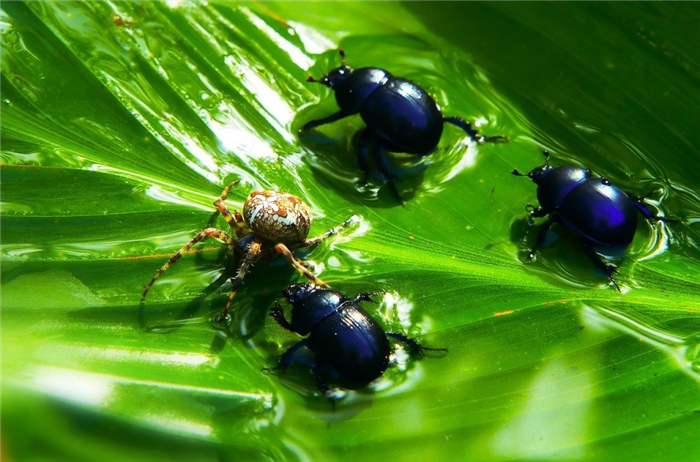
Beetle triad trying to prey on a spider (Photo Credit : Pixabay)
Aquatic Creatures
This is most surprising diet of certain beetles. Yes, they eat certain aquatic creatures and amphibians.
Amphibians are larger than beetles and can easily swallow them, but beetles like predaceous diving beetles are able to not only circumvent their predators, but also feast on them! They entice amphibians like frogs and toads to attack them, but when they do so, the beetles whip around and sink in their huge jaws slowly draining the life out of the unsuspecting amphibian. Their sharp jaws inject chemicals that help in digesting such large prey with ease. Some people believe that some beetles can even hunt snakes!
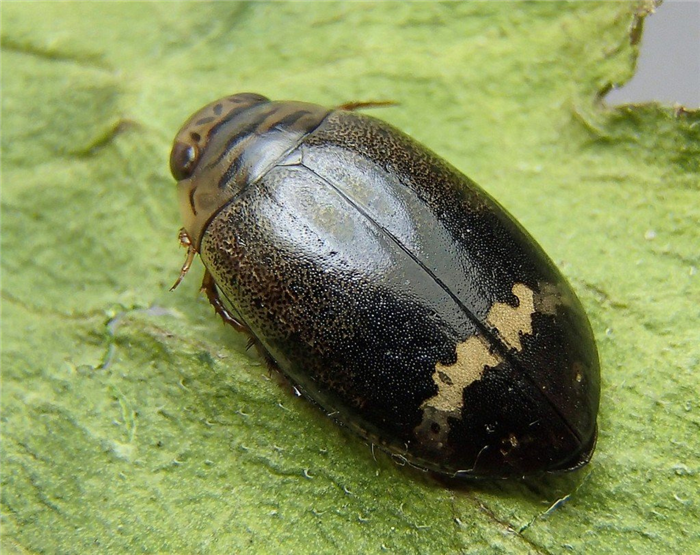
Predaceous diving beetle (Photo Credit : promiseminime / Flickr)
Whirligig beetles are known to feed on aquatic insects and crustaceans. Similarly, water beetles are widely known to feed on tadpoles.
Beetle
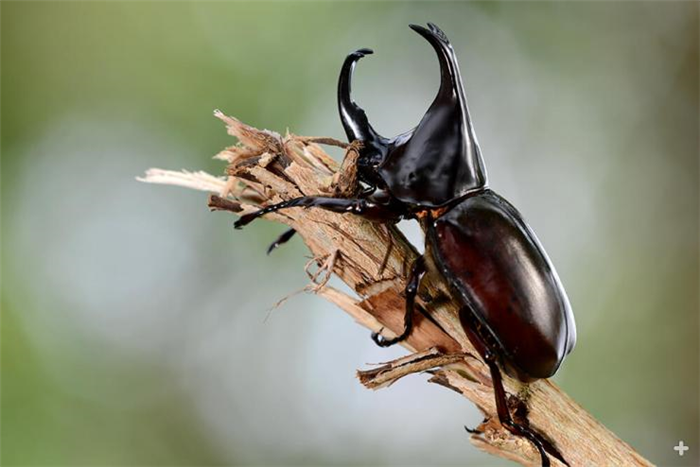
Beetle-mania. Beetles are the largest group in the Animal Kingdom, representing about a fourth of all animals. Currently, more than 350,000 beetle species have been identified. Yet scientists who study beetles (coleopterists) are certain there are thousands more that have not been discovered yet!
You may be familiar with some of the many different beetles by their common names: ladybugs, June bugs, weevils, lightning bugs or fireflies, borers, and potato bugs. No other group has such a range of color, shape, and size. Some beetles are as large as your fist; others are so small they can fit through the eye of a needle. Many are brilliantly colored, like jewels, while others cleverly blend into their environment.
Beetle body parts. The body of the beetle consists of three main segments: head, thorax, and abdomen.
Head— The head is where the beetle’s eyes, mouth, brain, and antennae are found. Some horned beetles have extensions on their head that remind scientists of horns or antlers.
Thorax— The thorax is the powerhouse of the beetle body, divided into three parts. The beetle’s six legs and its wings are attached to these parts. Thick, hardened front wings, called elytra, cover most of the beetle’s body and its back wings offer great protection. Some are able to trap moisture under their wings, helping them survive in deserts where water is scarce. Others can live underwater because they are able to trap air under the elytra.
Abdomen— The abdomen contains the organs for digestion and reproduction. A tough exoskeleton and the elytra protect the beetle’s soft membranes and keep the beetle from drying out or getting waterlogged.
Flexible, long antennae on the beetle’s head act like feelers to help the beetle find food, a mate, and places to lay eggs. They also alert the beetle to vibrations in the air that could mean a predator is near. A beetle uses its legs to regularly clean those important antennae. Tiny hairs on its body and legs, called setae, are sensitive to touch, sound, smell, taste, and light.
Most beetles have compound eyes (eyes that are divided into many six-sided compartments). Compound eyes are very sensitive to movement and can probably see in color. Beetles that rely on vision for hunting (ground beetles) or breeding (fireflies, Lampyridae family) have larger eyes. Whirligig beetles (Gyrinidae family), which swim on the surface of ponds, have divided eyes: one half for vision under water, the other for seeing above the water so they can find food that drops in or floats by.
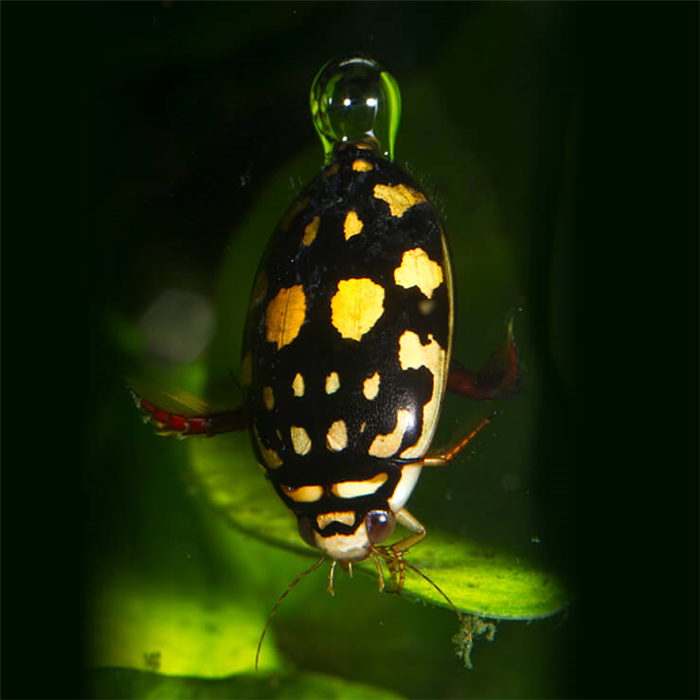
Sunburst diving beetles carry a bubble on their rear end that pulls oxygen from the water and helps the beetle stay under just a little longer.
Most beetles can fly, although they do so in a slow, clumsy manner. Water beetles are good swimmers, and many can fly as well. Some beetles that live in deserts have lost the ability to fly.
All beetles have jointed legs, but leg shape and size varies, depending on the beetle’s lifestyle. For example, long and slender legs are made for speed (ground beetles, Carabidae family); broad and ridged legs are for digging (dung beetles, Scarabaeidae family); legs curved and shaped like a paddle are for swimming (water beetles, Hydrophilidae family); and large hind legs are for hopping (flea beetles, Chrysomelidae family). Some even have a sticky pad on the bottom of each foot to help them walk up slippery surfaces. All beetles have a pair of claws on each foot. Many beetles need the sun to warm their bodies before they can run or fly quickly.
Stay safe! Beetles have a lot of different ways to protect themselves from becoming someone else’s lunch. The hard, shiny elytra is often enough to keep a beetle safe from other insects, or other beetles! Dome-shaped leaf beetles (Coccinelidae family) and ladybird beetles (Chrysomelidae family) pull their legs and antennae under this “shell,” just like a turtle does. Some ladybird beetles release sticky yellow blood from their legs to gum up the antennae and mouthparts of the attacker.
Flightless ground beetles squirt out jets of formic acid, which burns the skin and causes eye damage. Leaf beetle larvae are so poisonous that people of the Kalahari Desert use them to tip their hunting arrows. Brightly colored or patterned beetles usually taste very bad to predators. And camouflage works great for beetles living under rocks or bark, or in the soil.
Critter Catalog
Beetles are like all insects, they have a head, thorax, and abdomen, and six legs. Their bodies tend to be very solid and tough. They have chewing mouthparts and often have powerful jaws. Adult beetles have modified wings: the first pair of wings is small and very hard, and acts as a protective covering for the second pair of wings. Many beetles can fly with their second pair of wings. Most adult beetles are brown or black, but some are very brightly colored. Beetle larvae look sort of like worms, but they have six legs and a hard head. Beetle pupa can’t move and are covered with a leathery skin.
- Other Physical Features
- ectothermic
- heterothermic
- bilateral symmetry
- polymorphic
- poisonous
- Sexual Dimorphism
- sexes alike
- female larger
- male larger
- sexes colored or patterned differently
- sexes shaped differently
- ornamentation
Where do they live?
Beetles are the most diverse group of insects. There are over 300,000 species known to science, and probably many tens of thousands more still unknown. Beetles are found on land and in fresh water all over the world.
Beetles are found in just about every habitat. Most species live on plants, others tunnel or burrow, some swim.
- These animals are found in the following types of habitat
- temperate
- tropical
- polar
- terrestrial
- freshwater
- Terrestrial Biomes
- tundra
- taiga
- desert or dune
- chaparral
- forest
- rainforest
- scrub forest
- mountains
- Aquatic Biomes
- lakes and ponds
- rivers and streams
- Wetlands
- marsh
- swamp
- bog
How do they grow?
Beetles have four different stages in their life cycle. Adult female beetles mate and lay eggs. The eggs hatch into a larval stage that is wingless. The larva feed and grow, and eventually change into a pupal stage. The pupa does not move or feed. Eventually the pupa transforms into an adult beetle.
- Development – Life Cycle
- metamorphosis
How do they reproduce?
- Mating System
- monogamous
Female beetles usually lay dozens or hundreds of eggs. Reproduction is often timed to match the time of most available food.
- Key Reproductive Features
- semelparous
- iteroparous
- seasonal breeding
- year-round breeding
- sexual
- fertilization
- internal
- Breeding season Breeding season varies, often in spring or summer
Adult beetles mate, and the female lays eggs on or very near a food source for her larvae. Some beetles collect a supply of food for their larvae, and lay the egg in the ball of food. Some scavenger beetles even feed their babies.
- Parental Investment
- no parental involvement
- male parental care
- female parental care
How long do they live?
Most beetle species complete their lives in a single year. Some, especially larger ones, live for more than a year, hatching in summer, a few months to a year or more as a larva and pupa, and then emerging to reproduce as an adult.
Most beetles are active at night, but some are active in daylight (especially if they have chemical defense). Often they time their growth and reproduction so all the adults emerge at once, and for a short time you can find lots of a particular species.
How do they communicate with each other?
Most beetles communicate with other beetles with chemicals. Males often locate females by their scent. Beetles usually can’t see very well. Some beetle make sounds, usually scraping their mouthparts together or rubbing their legs on their bodies. Some beetles that live in dead wood drum and make vibrations. “Fireflies’ and “lightning bugs’ are actually beetles. They glow in the dark to communicate.
Beetles eat all kinds of food. Most are specialists in few kinds, but some, like ground beetles, eat lots of things. Most beetles eat plant parts, either leaves or seeds or fruit or wood. Many are predators on other small animals. Some eat fungus, and there are a bunch of species that eat dung. Sometimes the larvae eat different foods than the adults do.
- Primary Diet
- carnivore
- eats terrestrial vertebrates
- eats eggs
- eats non-insect arthropods
What eats them and how do they avoid being eaten?
Most beetles hide, and many beetle larvae dig tunnels to hide in. Some rely on their hard shell. Some, like lady beetles, have toxic chemicals to repel predators. Some can bite. Some, like ground beetles, run fast.
- Known Predators
- moles
- shrews
- mice
- rats (like beetle larvae)
- woodpeckers
- other insect-eating birds
- frogs
- toads
- salamanders
- other beetles
- fish
- wasps
- ants (when they can bite through the shell)
What roles do they have in the ecosystem?
Beetles have lots of roles. Dung beetles help get rid of waste, beetles that eat wood help break down dead trees, some beetles feed on pollen and help pollinate flowers.
- Ecosystem Impact
- pollinates
- biodegradation
Do they cause problems?
Beetle species are important pests because some of them eat our food. Some eat fruits or vegetable or other crops in the field, and others eat them in storage. Farmers have to spend lots of money and energy protecting their crops from beetles. Some beetles tunnel in wood, and these can kill or damage trees, or damage things we make from wood, like furniture, or even houses!
- Ways that these animals might be a problem for humans
- injures humans
- bites or stings
How do they interact with us?
Some beetle species are important predators of pests, and others do valuable clean-up jobs, getting rid of dung and breaking down dead plants. A few species are now being used to eat problem weed plants as well.
- Ways that people benefit from these animals:
- controls pest population
Are they endangered?
Most beetle species are abundant, and don’t need to be especially conserved. Beetles that live in habitats that are getting changed or wiped out could be in trouble, and some beetles depend on certain plant species. If the plant goes, they go. There is a species of aquatic beetle that only lives in a few rivers in northern Michigan. It is considered endangered.
- IUCN Red List [Link] Not Evaluated
Some more information.
The heaviest insects in the world are beetles. There are some African and South American beetles that are as big as your fist!
. “Coleoptera” (On-line), Animal Diversity Web. Accessed August 24, 2022 at http://www.biokids.umich.edu/accounts/Coleoptera/
BioKIDS is sponsored in part by the Interagency Education Research Initiative. It is a partnership of the University of Michigan School of Education, University of Michigan Museum of Zoology, and the Detroit Public Schools. This material is based upon work supported by the National Science Foundation under Grant DRL-0628151.
Copyright © 2002-2022, The Regents of the University of Michigan. All rights reserved.What Do Beetles Eat?
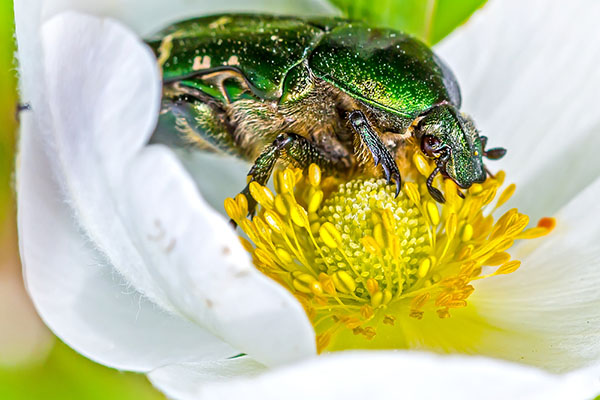
The typical beetle diet is anything but standard, meaning the answer to “what do beetles eat” is a bit long-winded. Why? Because there are more than 300,000 identified species of beetles, with possibly millions more out there waiting to be discovered by entomologists. And since each species has its own unique tastes, their food sources can essentially be described in one word: everything.
Beetle diet breakdown
The easiest way to answer a question like “what do beetles eat” is to break it down into smaller subcategories of species by diet type.
- Most beetles are herbivores, eating only plants. This includes roots, stems, leaves, seeds, nectar, fruits or even the wood of the plant itself. This subcategory includes weevils, leaf beetles and some species of Longhorned beetles.
- There are also a lot of beetles that are predators, including most species of ground beetle. Prey includes fly maggots, earthworms, snails, grubs, slugs and even other species of beetles. Hunting methods vary. The tiger beetle runs quickly to grab prey in their enormous mandibles, while lightning bugs and soldier beetles pick aphids and caterpillars off of leaves, something that helps your garden.
- Beetles species that are saprophagous feed on dead organic matter, be it plant or animal. This subcategory includes the dung beetle, which feeds on animal waste, and the hide beetle, which scavenges for dead carrion, burying and using the meat as a food source for their larvae.
- Wood boring beetles, that include powder post beetles and Longhorned beetles, can cause large amounts of damage to homes. They can feed on structural wood, decorative wood pieces and furniture. They are also sometimes found in newly constructed homes.
- Other subcategories include beetles that feed on fungus, such as the mildew beetle, and beetles that eat crustaceans, such as the whirligig beetle. Some beetles are parasitic and eat beetle larvae, while other beetles feast on fabrics and textiles, such as the carpet beetle.
What the beetle diet tells us
Recent theories proposed by the University of Berkeley claim that there might be so many different species of beetles because of what they choose to eat. For example, if one species of beetle is eating a particular flower, it might become scarce as the population grows. Half of that species might start to eat another flower. The group that switches might evolve to become another species.
It’s easy to see why entomologists are excited about beetles and their diets, but Terminix® understands that you aren’t as thrilled when you find out the beetle diet includes just about everything in and around your home – your house included. Call for your free pest estimate and tell beetles that the buffet is closed.
Other Animals
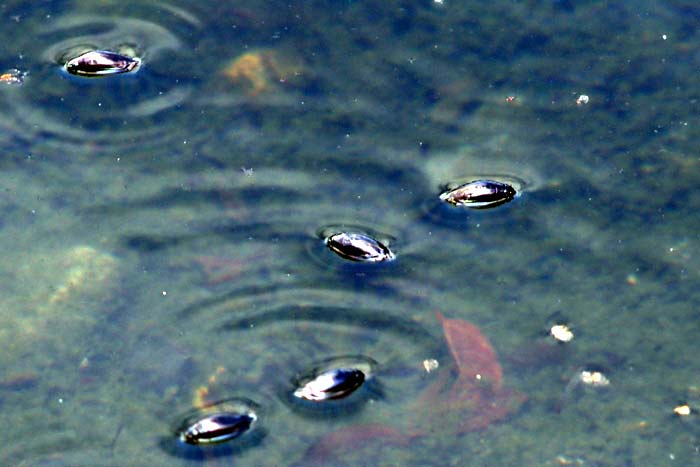
Interestingly, a species of water beetles known as the Predaceous diving beetle Dysticus sp. Is living up to its name because it acts as a predator to other water bugs, amphibians, and some snakes!.
- Water beetles eat tadpoles.
- Another awesome example is the adult whirligig beetles and their larvae. These beetles are known to be carnivorous and feed on aquatic insects and crustaceans.
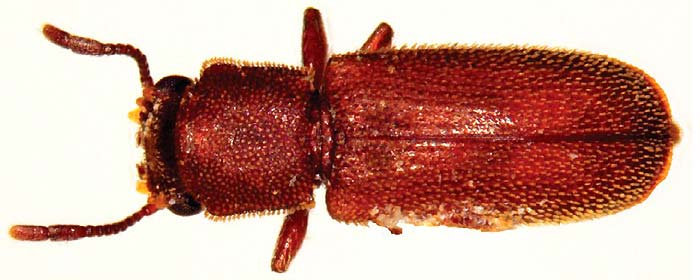
Coleoptera is the largest order of the class of insects. In fact, scientists believe that more species of insects under this order are yet to be identified and be added to the 400,000 known species.
Who knows they might discover beetle species that eat more bizarre things than those already mentioned?
